Chapter: 11th Physics : UNIT 6 : Gravitation
Acceleration Due to Gravity of the Earth
ACCELERATION
DUE TO GRAVITY OF THE EARTH
When
objects fall on the Earth, the acceleration of the object is towards the Earth.
From NewtonŌĆÖs second law, an object is accelerated only under the action of a
force. In the case of Earth, this force is the gravitational pull of Earth.
This force produces a constant acceleration near the EarthŌĆÖs surface in all bodies,
irrespective of their masses. The gravitational force exerted by Earth on the
mass m near the surface of the Earth is given by

Now
equating Gravitational force to NewtonŌĆÖs second law,

The
acceleration experienced by the object near the surface of the Earth due to its
gravity is called acceleration due to gravity. It is denoted by the symbol g.
The magnitude of acceleration due to gravity is

It
is to be noted that the acceleration experienced by any object is independent
of its mass. The value of g depends only on the mass and radius of the Earth.
Infact, Galileo arrived at the same conclusion 400 years ago that all objects fall towards the Earth with the same acceleration through various quantitative experiments. The
acceleration due to gravity g is found to be 9.8 mŌĆåsŌłÆ2 on the
surface of the Earth near the equator.
Variation
of g with altitude,
depth and latitude
Consider
an object of mass m at a height h from the surface of the Earth. Acceleration
experienced by the object due to Earth is
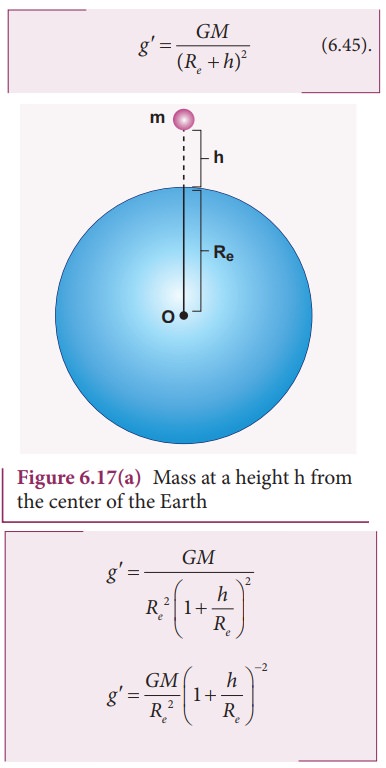
If
h << Re
We
can use Binomial expansion. Taking the terms upto first order
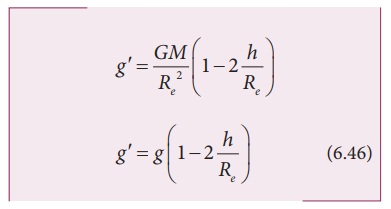
We
find that gŌĆÖ< g . This means that as altitude
h increases the acceleration due to gravity g decreases.
EXAMPLE 6.7
1.
Calculate the value of g in the following two cases:
a)
If a mango of mass ┬Į kg falls from a tree from a height of 15 meters, what is
the acceleration due to gravity when it begins to fall?
Solution
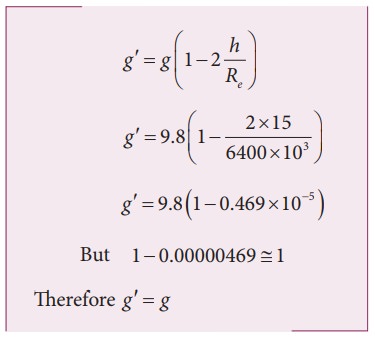
b)
Consider a satellite orbiting the Earth in a circular orbit of radius 1600 km
above the surface of the Earth. What is the acceleration experienced by the
satellite due to EarthŌĆÖs gravitational force?
Solution
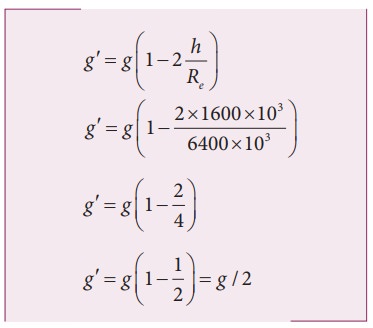
The
above two examples show that the acceleration due to gravity is a constant near
the surface of the Earth.
Variation of g with depth:
Consider
a particle of mass m which is in a deep mine on the Earth. (Example: coal mines
in Neyveli). Assume the depth of the mine as d. To calculate gŌĆ▓ at a depth d, consider the
following points.
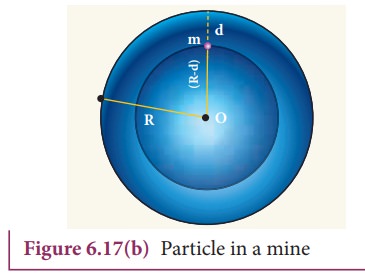
The
part of the Earth which is above the radius (Re ŌłÆ d)
do not contribute to the acceleration. The result is proved earlier and is
given as

Here
M ŌĆÖ
is the mass of the Earth of radius (Re-d)
Assuming
the density of Earth Žü to be constant,

where
M is the mass of the Earth and V its
volume, Thus,


Here
also g ŌĆ▓ < g . As depth increases, gŌĆ▓
decreases. It is very interesting to know that acceleration due to gravity is
maximum on the surface of the Earth but decreases when we go either upward or
downward.
Variation of g with latitude:
![]()
![]() Whenever we analyze the motion of objects in rotating frames
[explained in chapter 3] we must take into account the centrifugal force. Even
though we treat the Earth as an inertial frame, it is not exactly correct
because the Earth spins about its own axis. So when an object is on the surface
of the Earth, it experiences a centrifugal force that depends on the latitude
of the object on Earth. If the Earth were not spinning, the force on the object
would have been mg. However, the
object experiences an additional centrifugal force due to spinning of the
Earth.
Whenever we analyze the motion of objects in rotating frames
[explained in chapter 3] we must take into account the centrifugal force. Even
though we treat the Earth as an inertial frame, it is not exactly correct
because the Earth spins about its own axis. So when an object is on the surface
of the Earth, it experiences a centrifugal force that depends on the latitude
of the object on Earth. If the Earth were not spinning, the force on the object
would have been mg. However, the
object experiences an additional centrifugal force due to spinning of the
Earth.
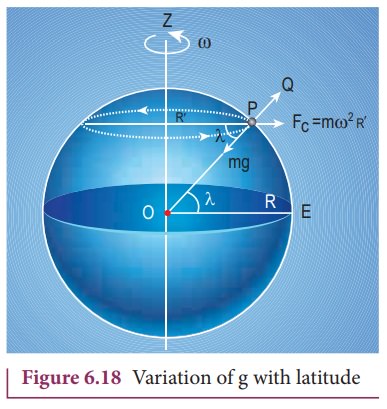
This
centrifugal force is given by mŽē2RŌĆÖ .

where
╬╗ is the latitude. The component of centrifugal acceleration experienced by the
object in the direction opposite to g is

Therefore,

From
the expression (6.52), we can infer that at equator, ╬╗ = 0; gŌĆÖ= g - Žē2R. The acceleration due to gravity is
minimum. At poles ╬╗= 90; gŌĆÖ=g, it is maximum. At the equator, gŌĆÖ is minimum.
EXAMPLE 6.8
Find
out the value of gŌĆ▓ in your school laboratory?
Solution
Calculate
the latitude of the city or village where the school is located. The
information is available in Google search. For example, the latitude of Chennai
is approximately 13 degree.
g
ŌĆ▓ =
g ŌłÆŽē 2 R cos2 ╬╗
Here
Žē2R = (2x3.14/86400)2 x
(6400x103) = 3.4x10ŌłÆ2 mŌĆåsŌłÆ2.
It
is to be noted that the value of ╬╗ should be in radian and not in degree. 13
degree is equivalent to 0.2268 rad.
gŌĆ▓ = 9.8 ŌłÆ (
3.4 ├Ś
10ŌłÆ2 ) ├Ś
( cos 0.2268)2
g = 9.7677 mŌĆåsŌłÆ2
Related Topics